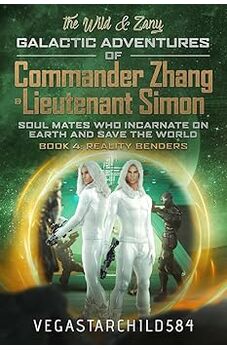

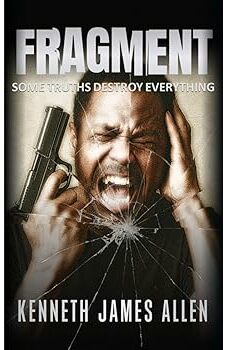
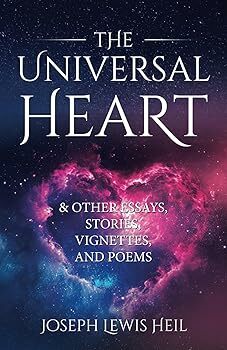
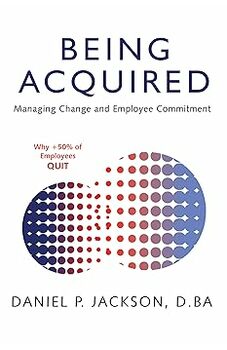
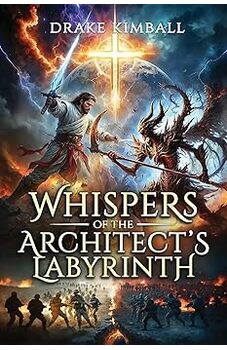
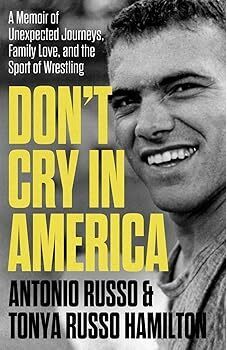
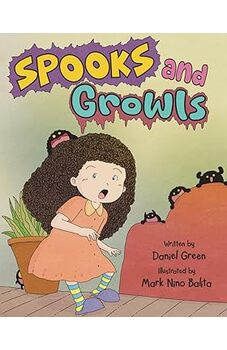
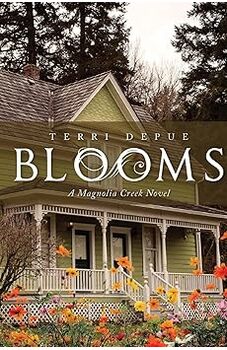
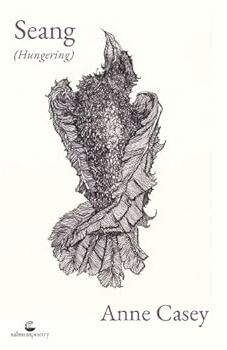
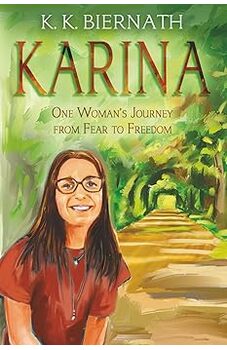
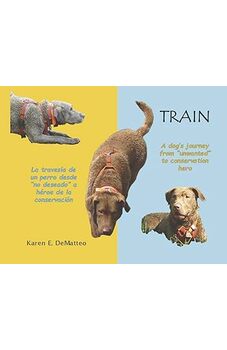

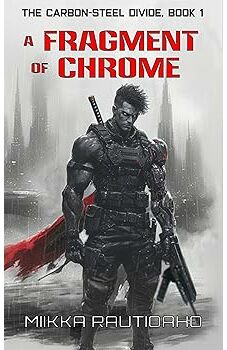
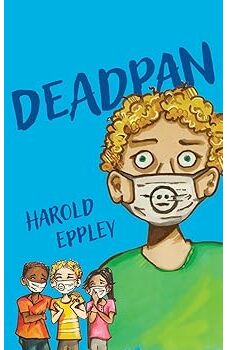
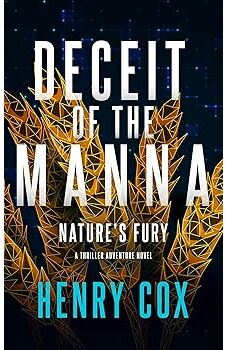
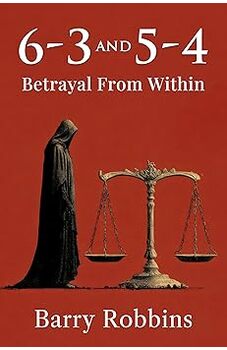
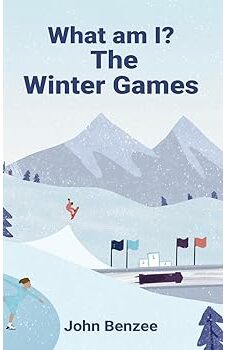
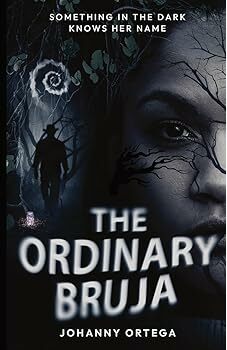
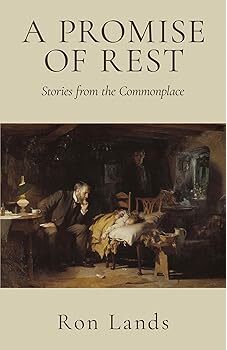
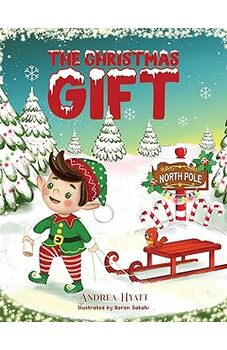


 This author participates in the Readers' Favorite Free Book Program, which is open to all readers and is completely free. The author will provide you with a free copy of their book in exchange for an honest review. You and the author will discuss what sites you will post your review to and what kind of copy of the book you would like to receive (eBook, PDF, Word, paperback, etc.). To begin, click the purple email icon to send this author a private email.
This author participates in the Readers' Favorite Free Book Program, which is open to all readers and is completely free. The author will provide you with a free copy of their book in exchange for an honest review. You and the author will discuss what sites you will post your review to and what kind of copy of the book you would like to receive (eBook, PDF, Word, paperback, etc.). To begin, click the purple email icon to send this author a private email.

Theodore J. Cohen, PhD, holds three degrees in the physical sciences from the University of Wisconsin–Madison and has been an engineer and scientist for more than 45 years. From December 1961 through early March 1962, he participated in the 16th Chilean Expedition to the Antarctic. The US Board of Geographic Names in October, 1964, named the geographical feature Cohen Islands, located at 63° 18' S. latitude, 57° 53' W. longitude in the Cape Legoupil area, Antarctica, in his honor. Cold Blood, The Antarctic Murders Trilogy, comprises three novels he wrote based on this expedition. Frozen in Time: Murder at the Bottom of the World (Book I) describes what happened following the robbery of the Banco Central de Chile in Talcahuano in May, 1960. Unfinished Business: Pursuit of an Antarctic Killer (Book II) reveals the events that unfolded between March 1962 and March 1965. End Game: Irrational Acts, Tragic Consequences (Book III), brings the series to a close, revealing the secrets to most but not all of the mysteries surrounding these thrillers.
Dr. Cohen has been an investor for more than 50 years, and recently has focused on investigating and reporting on corruption in US financial institutions and agencies of the US government. His latest novel, Eighth Circle: A Special Place in Hell, brings back NYPD Homicide Detective Louis Martelli, the hero he introduced in Death by Wall Street: Rampage of the Bulls, and who later reprised his role in House of Cards: Dead Men Tell No Tales, Lilith: Demon of the Night, and Night Shadows. Dr. Cohen also authored the novel Full Circle: A Dream Denied, a Vision Fulfilled as well as more than 450 papers, columns, essays, and interviews for the popular, scientific, and technical literature.
Reviewed by Lee Ashford for Readers' Favorite
Cold Blood: The Antarctic Murders Trilogy by Theodore Jerome Cohen is a spellbinding thriller of subterfuge, murder, deception and betrayal spanning the globe. From the ice-veiled waters off the Antarctic shores, to Chile, Brazil and Europe, Captain Mateo Valderas of the Chilean Navy has spent over ten years tracking the movements of his primary suspect in multiple crimes. Although he is convinced beyond a doubt who the guilty party is, he cannot seem to find evidence that is not circumstantial with which he could convince a judge or jury or Military Board of Inquiry of the man’s guilt. Through it all, his suspect openly taunts him, adding further fuel to the investigator’s frustration. Is Valderas destined to spend the rest of his career haunted by his inability to close this investigation? Or will he ultimately see justice done?
Cold Blood: The Antarctic Murders Trilogy is comprised of three previously released novels: Frozen in Time, Unfinished Business, and End Game. The three novels are based on a true story, which the author was fated to experience first-hand in the course of accomplishing his post-graduate college research. Cohen has written at least 10 novels altogether, and is eminently qualified to devise a fascinating tale from his experiences. Cold Blood is very well-written, and is loaded with interesting factoids germane to the story. Cohen knows how to tell a story, and Cold Blood is one you won’t soon forget. The three novels of which it is comprised can be read as standalone tales, but most readers likely will prefer reading the entire saga under one cover. If you enjoy believable fiction based on facts, Cold Blood is the book for you.
For Pacific Book Review
I must confess I like the writing style of Theodore Jerome Cohen, so personally Death by Wall Street: Rampage of the Bulls paged like a gift from a friend. The reasons I like his style so much, aside from his exceptional character development, sophisticated plot machinations and superb use of suspense, is Ted Cohen uses many footnotes; offering Internet links, or additional insight to the material written. Dealing with a factious story and having the juxtaposition of factual detail as current web links seems to bring a heightened sense of authenticity and credibility to his writing. Furthermore, Ted Cohen is a brilliant person with a cache of knowledge; one feels as if he’s educating the reader in a humble way as he unfolds his storyline. He enlightens the reader to little known nuances of the industry that have come to his attention throughout his years of experience and his countless hours of research.
In Death by Wall Street, Theodore Cohen begins by revealing a grotesque murder; a nauseous sight of a decapitated head impaled on the horns of the famous Charging Bull bronze sculpture in the financial district of NYC -- a grim spectacle analogous to the scene along the path leading to Count Dracula’s castle. The case is turned over to homicide detective specialist Lou Martelli, a street smart cop that is quoted, “If you live long enough, you get to see everything.” As detective Martelli begins to dig into the surrounding circumstances, the reader is educated as to the inner workings of Wall Street trading, the FDA’s approval techniques for new pharmaceuticals, and the manipulation of the stock market for personal gain, irrespective of those that may die as a consequence.
For Reader Views
Theodore Jerome Cohen has chosen to use the medium of the novel as a platform to express his repugnance for the brazen manipulation of the stock market in the field of biotechnology. As a result of the collusion among pharmaceutical developers, unscrupulous doctors, Wall Street stock analysts and inaction by government agencies, the lives of innocent victims are put jeopardy. “Death by Wall Street” is a work of fiction. The story is based upon real events.
Three separate murders appear to be related because the heads of the victims were severed and left to be discovered in prominent places. One is found pinned to the horn of the bronze sculpture “The Charging Bull” in Bowling Green Park near Wall Street. Another is left in the lap of Robert Aitken’s statue “Future” at Federal Triangle on Pennsylvania Avenue in Washington, D.C. The final of the trio is propped against the window on the driver’s side of his black Mercedes-Benz, which is parked near the delivery dock behind the Delacourt Theater in Central Park.
The public, the mayor’s office, and the chief of police are all clamoring for results, a quick arrest, and closure to these heinous crimes. Feeling “strangled” himself, Homicide Detective Louis Martelli of the NYPD is forced to think outside the box to solve the case.
Cohen proves to have an innate ability to instill believability in his fictional characters. Steve Jacobs, John Williamson, and Tricia Fournier represent the various levels of stock market analysts. They demonstrate the corruption, greed and lack of ethics often resulting from affluence.
Dr. Broussard is the embodiment of the persona without moral fiber. Ruthless and unprincipled, he smears the reputation of all his peers in the medical profession.
Detective Martelli and his support team of experts in crime detection, although somewhat devious on occasion, are examples of the finest in character, dedication, and loyalty to public service.
I especially appreciate Cohen’s strong characterizations and attention to detail. I admire his boldness to speak out with a keen sense conviction on the unethical practices flagrant in industry and government today.
Detailed footnotes document instances where facts are introduced into the fictional account. Important background information on Wall Street practices, drug research, and investigative procedures added to my personal enjoyment of Cohen’s writing style. This is a book that should be added to the reading list of college and university classes in ethics, political science, finance, business, law, science, and medicine.
“Death by Wall Street: The Rampage of the Bulls” will be enjoyed by mystery readers who enjoy matching wits with the protagonist and by concerned citizens eager to see reformation in steps to enforce the laws regulating US financial markets and the nation’s health care practices.
…Cutting edge reporting, important insight, timely, and relevant… “Death by Wall Street: Rampage of the Bulls” is destined to firmly establish Theodore Jerome Cohen as a fresh voice in literary journalism
For Feathered Quill Book Reviews
Arturo Di Modica probably never in a million years would have expected such a macabre addition to his sculpture, the Bowling Green Bull, and neither did Homicide Detective-Specialist, Lou Martelli. The cobbled bricks below the sculpture caught the droplets of blood dripping from the severed head of an unknown man who later proved to be that of John Williamson, a senior financial analyst from Bartlett, Cline, and Stephenson. The bull’s left horn held the head aloft so all approaching the Financial District might see him at sunrise, the last sunrise Williamson’s unseeing eyes would ever behold. Martelli, who approached the scene, was no stranger to death and destruction and, as an Iraq vet, was able to keep his emotions in check. His prosthetic leg was testament to that fact, but another seasoned vet of a different sort of war altogether was already on the scene.
For Michael Antonetti, Deputy Coroner, it may have been just the start of another day, but even he had to admit this was a weird case. Bagging evidence of this sort was, at the very least, distasteful. On one level it was quite apropos as Wall Street, the ‘Street,’ was “home to the oligarchs who raped and pillaged Main Street while awarding themselves outrageous salaries and stock options, their ‘rewards’ for having cheated, swindled, and defrauded the Middle Class of its savings and retirement funds.” (pg. 3) Antonelli pointed out a possible friend of the vic, who was adding some of his own bodily fluids to the streets of Manhattan, and soon the wheels of Martelli’s mind would begin to turn when he began to interview Steve Jacobs. Blood and vomit were no way to start anyone’s day, but it was what he’d signed up for.
Lou, as most people called him, listened as hints of something more insidious were interwoven with Jacobs’ tale as were the expected tidbits that gave a glimpse into the personality of that “arrogant sonofabitch,” who was now history. Jacobs began to spill a tale of stock manipulation in the biotech field that if it were true would not only have sent stocks tumbling, but would have impacted the lives of millions. HerDeciMax was a drug in the forefront to cure breast cancer, but that sonofabitch squelched the stock, the monies from which would have completed the medical staging. “You can make more money betting against a biotech company succeeding than on the possibility it will bring a product to market.” (pg. 14) Jacobs gave Lou more than a running start in this case, but soon there were more heads rolling.
Dr. Paul K. Broussard, oncologist and a consultant to the National Cancer Institute, who suffered the same fate as Williamson, was found “in the lap of Robert Aiken’s stature Future” in DC. The MO was the same and the Capitol Hill Police probably had someone puking up a storm down there. They weren’t NYC cops and weren’t used to the oddball stuff. Missy Dugan, a Principal IT Specialist had given him two numbers from a license plate from Iowa. A ‘2’ and a lucky ‘7’ weren’t much to go on. Someone was onto the salty, seasoned detective. “I need the e-mail server cleansed of all e-mails sent by, or to, John Williamson. Delete them! Make him disappear. Erase any sign that the man ever existed ….” (pg. 80) Why would Wall Street futz with the lives of the innocent? Was someone trying to exact revenge for the Berranger biotech fiasco? Would Lou be able to find the perp before another head rolled?
A simple, childish connect the dots exercise would change this fictional treatise on the seedy Wall Street manipulation of critical biotech stock into an explosive exposé.
Naturally it would be an exposé that would reveal the unethical, murderous practices carried out beneath our very noses while the SEC and the FDA look the other way.
Seldom do we find ourselves rooting for the perpetrator of such heinous murders, yet anyone reading this novel will quickly discover some modicum of sympathy for him.
This is an excellent police procedural, yet I quickly sensed that the intent of the author was not to introduce a series with Lou Martelli at the forefront, but rather to use this book as a vehicle for his ‘theory’ of devious dealings in the Wall Street Financial District. The delicate balance between churning out information on the role of Wall Street and its dealings with the biotechnology industry and the presentation of a murder mystery was quite well done. This is the type of work that actually leaves one with a few more unanswered mysteries that even Lou Martelli couldn’t solve. Have you or any of your loved ones been a victim of Wall Street? Perhaps you’ll never know.
Quill says: If you want the real scoop on the insidious dealings of Wall Street vs. the biotech industry, you need only follow Detective Lou Martelli as he unravels the threads of death and injustice as only a NYC cop can do!
Book I: Frozen in Time
A nasty little piece of skullduggery made all the more so by the fact that this fictional tale is based on real events in the author’s life.
When the Great Chilean Earthquake shook the country in 1960, it knocked the roof off the Chilean Central Bank in Talcahuano and millions of dollars in cash, gold, negotiable securities and jewelry were stolen. In Cohen’s tale, the culprits are two Chilean Navy seamen who are sent to protect the bank but stash the loot in a refrigerator instead. (In order to encourage service in Antarctica, members of the Chilean military are allowed to import white goods without the ruinous taxes as long as the goods travel with them to Antarctica first.) Thus the two thieves encounter an expedition sent to the Antarctic by the University of Wisconsin. Ted Stone is part of the expedition, and Stone is Cohen’s fictional standin.
In the neatly blocked-out story that follows, it’s fun to try to discern the real stuff from the fictionalized. Probably most of it is true, including three grisly murders and a near-death experience for Cohen, but there is no doubt about the veracity of the expedition’s atmosphere, ably drawn and suitably paced. The entire route from Madison, Wis., to the Antarctic Peninsula is followed, with special attention paid to the hellacious storms at sea amid the powerful Shrieking Sixties winds and the potentially dangerous fieldwork where, if orcas don’t upend your boat and gobble you down before you get to your destination, you’ll likely fall in a crevasse when you arrive. Cohen doesn’t overdue the science, though he does introduce his gravity-related research and elements of his geological-specimen gathering, as well as a short course in amateur radio operation, clearly a hobby of the author’s, though also critical to the unfolding of events. The book has some mild quirks that interfere with the story’s flow—odd uses of italics and quote marks, strange footnotes—but the greatest mystery of all is why Cohen has put the story down on paper, when there may be many dangerous characters still out there.
An intriguing look at the surprisingly perilous life of a geologist.
Book I: Frozen in Time
Ted Stone would often rub a six-inch scar on his leg, a scar that could easily take his mind back in time more than forty years. It was a time of murder, mayhem, yet a time when memories of accomplishment could just as easily be tucked in the folds of adventure on the North Antarctic Peninsula in February of 1962. It was an austral summer that would become as ingrained in his mind as much as the scar on his leg. Ted, a young grad student at the University of Wisconsin, was going to help fellow student, Canadian Grant Morris, collect much needed rock and fossil specimens needed for his doctoral dissertation. Dr. Woollard also knew when opportunity came knocking and quickly convinced Ted of “the importance of the International Gravity Network and the need to acquire additional data at the end of the North Antarctic Peninsula.” (pg. 25) Ted realized he might be taking on too much, but a Worden gravimeter was added to his packing list.
Two years before the expedition, an earthquake measuring 9.5 on the Richter scale rocked Chile on May 22, 1960, but at the same time a country was feeling the devastation nature can wreak, two men stepped forward to lay claim to unimaginable treasure. Two Chilean NCOs, Raul Lucero and Eduardo Bellolio, worked late into the night rifling the safety deposit boxes in the Banco Central de Chile vault, a vault they should have been guarding. The riches were indescribable...imagine an 18K yellow gold Patek Phillipe simply there for the taking. After secreting their cache, the two heavily tattooed thugs would hide behind their jobs, jobs that would later bring them in contact with a young gringo, Ted Stone.
The team from the University was prepared to work and had made provisions for survival in an unforgiving climate, but they were unprepared for something else at Base Bernardo O’Higgins. The evil was on the move with them as Lucero and Bellolio too made their voyage to that “wind- and snow-swept outpost on the North Antarctic Peninsula...one of the oldest, permanent bases on the frozen continent.” (pg. 89) Meanwhile, Ted began to take readings with the gravimeter to tie his station into the Antarctic Gravity Network and Grant began to see great possibilities in the bleak landscape.
The team began to work, yet were totally unaware of the danger that hung over their heads. Lucero and Bellolio met on the ice, but a third man decided to push the envelope and blackmail them. The business at hand was to kill seals because the dog team needed to be fed. Yes, yes. He could have more money. The bloody seal lay next to the blackmailer. Lucero and Bellolio boarded the launch leaving him behind. “One by one the orcas placed their heads on the iceberg, attempting to use their weight to tip the ‘seals’ into the water.” (pg. 109) The blood had begun to flow at the bottom of the earth.
Who would be next? Were the treasures of Chile worth the lives of all on the expedition? The echoes of Captain Robert F. Scott’s voice were almost palpable as the landscape roared, “Great God! This is an awful place!”
This marvelous blend of long ago memories and fiction slowly draw the reader down to the end of the earth and onto the Continental Glacier where a small group of men suddenly found themselves unexpectedly fighting for their very existence. The tale does not thrust the reader into the crashing waves of drama immediately, but rather draws him in slowly. One of the things I liked most about this book was the leisurely way in which I found myself voyaging south right along with the team. With the descriptive passages of the landscape and the unforgiving climate one can almost picture Sir Ernest Shackleton working and struggling alongside the young men as they worked. The twists and turns of this adventurous mystery were not immediately evident, but rather surfaced toward the end of the book. There are several black and white photographs interspersed throughout the book that created a wistfully nostalgic view of this adventure. Numerous footnotes are included for those interested in knowing more about topics mentioned in the book.
Quill says: If you like your fiction to read like dramatic nonfiction, Theodore Jerome
Cohen will be more than willing to accommodate your request as he takes you to the bottom of the Earth where you’ll find murder and mayhem blended with a dash of chilling drama!
For Pacific Book Review
Book I: Frozen in Time
Theodore Jerome Cohen wrote Frozen in Time: Murder at the Bottom of the World in a genre all of his own by combining fact with fiction, reality with storytelling, and history with adventure. This unique combination of writing is a style unto itself, simultaneously delivering exceptionally high entertainment value while providing immense educational insight. Based on Dr. Cohen’s true once-in-a-lifetime adventure of a journey to Antarctica, back in the early 1960’s as a younger man, he actually did embark on a mission to monitor the gravitational field of the earth for scientific research. As one would think memoirs of such a fantastic journey would be sufficient material for fascinating reading, Theodore Cohen goes further in Frozen in Time by interlacing within the novel a factious story about a theft of grand proportions. The escape path along with the stolen wealth finds its way on the Piloto Pardo, a vessel in the port of Punta Arenas, Chile, destined to Antarctica, along with the “cast and crew” – the cast of characters and crew of the vessel.
What is most unique is how Dr. Cohen, a Ph.D. in real life with more degrees than all of the thermometers in Antarctica, writes specific details and events which actually did occur, along with the fictional account of “the heist.” Citing real events, Theodore Cohen includes in the galley text an abundance of footnotes allowing the reader expert insight of the details of the story’s true aspects. This creates a clear dichotomy of fact versus fiction, as the footnotes bring to the reader’s attention avenues for further research, or expert explanations of the true circumstances described. Then are the elements of his plot, character development, and twist of fate of the “novel” aspect of Frozen in Time. Together one perceives a window into the soul of the author, who simply changes his last name from Cohen to Stone for the sake of the story, but still is called Ted. I enjoyed the progression of the true events as the book continued, while also enjoying the “cat and mouse” of the crime; in essence reading two books within one novel. Having the human survival aspects combined with human greed made this the unique book it truly is.
Meticulously written, footnoted, including photographs, maps, memorabilia from the voyage, Frozen in Time: Murder at the Bottom of the World is an author’s doctorate work in novel creation, hardbound with chilling cover art. I am told by the author the characters are soon to reemerge in a sequel. Frankly, from the mind of Ted, a series of life’s adventures must certainly be awaiting his keyboard for release.
I certainly recommend this book for the travel enthusiast, adventure seeker, scientist and thrill seeking novel nerds among us, as well as anyone looking to read something different and as true to life as fiction can be.
For Reader Views
Book I: Frozen in Time
Theodore Cohen goes back to a time in his life to create a fictional story based on his own real-life experiences during the Austral summer of 1961 -1962. He was part of a Chilean Antarctic expedition with a team of scientists from the University of Wisconsin doing a gravity survey. The work was down on the North Antarctic Peninsula.
Cohen carefully builds a plot which includes natural dangers of weather and environment, criminal activity, greed, and murder. Cohen uses actual events which occurred during the period 1958 through 1965. Real people from his life, fictional characters, and fictional agencies and organizations are all a part of the carefully developed plot. Cohen incorporates the Great Chilean Earthquake of May 22, 1960 and the theft of valuable assets from the bank’s safe deposit boxes valued at millions of dollars to build suspense that leads to an unexpected surprise ending.
The following is typical of Cohen’s amazing descriptions: “ a world of ice, enveloping, looming over, and dominating the landscape…melting cracking, separating, inching inexorably toward the sea, calving in thunderous convulsions that send thousands of tons of ice and snow pouring down from great heights…”
The University of Wisconsin team had a threefold objective. Grant mapped large portions of the area and collected a variety of rocks and fossils that he needed in defense of his doctoral theses in Cretaceous sedimentation. David similarly was collecting rock samples needed for his doctoral work. Ted was working to establish a new gravity network in the Chilean Antarctica.
The book is thoroughly researched, fully documented, and highly informative. Ham radio operators will appreciate the detailed descriptions of strategies involved in communicating worldwide with Ham radio and other high frequency communications. Avid Chess fans will enjoy the reference to highly complicated chess moves and mention of various well-known Chess Tournaments. Frequent references to Catholic tradition and rites will be of interest to practicing Catholics.
I appreciated the use of the Spanish language when appropriate in the dialog with the easy reference to the English translation. I was enthralled with Cohen’s account of the Chinstrap penguins (a rookery of over 100,000.) Cohen’s own pictures, other photos, maps and illustrations add a stunning visual dimension to the narrative.
Cohen writes with depth, authenticity, and meaning as he draws from his own experiences. He adeptly expresses the feelings, emotions, and psyche of his characters. It became difficult to pinpoint where biographical writing ended and fiction began.
“Frozen in Time” is compelling reading combining the elements of conflict, suspense, intrigue, entertainment, and enlightenment. I highly recommended it.
Book II: Unfinished Business
Cohen (Frozen in Time, 2010) tenders part two [Book II] of his murder and grand-theft trilogy, a fictionalized story inspired by real events.
The loot that was stolen in the first installment of this series—millions in cash, gold coins and jewelry that two Chilean Navy seamen absconded with after being assigned to guard a bank damaged during Chile’s great earthquake of 1960—continues to leave death in its wake as the action shifts from Antarctica to Chile. The goods are now in the hands of Cap. Roberto Muñoz, also of the Chilean Navy, who dispatches the previous owners in a grizzly but very neatly organized murder, detailed with significant brio by Cohen in the novel’s opening pages. Unfortunately for Muñoz, he has come under the suspicion of his old friend, Cap. Mateo Valderas, and his young sidekick in Internal Affairs, Lt.-Cmdr. Antonio Del Rio. Muñoz and Valderas had been at the naval academy together and knew each other’s minds fairly well, so the stage is set for a leisurely if menacing game of cat and mouse, with Muñoz staying a step ahead of the investigators while taunting Valderas with little clues in the form of rare and valuable coins (Valderas is a numismatics buff). Cohen keeps Valderas in hot pursuit, and there are moments when it appears that Muñoz might be too smart for his own good, but he never surrenders any hard evidence. The extended dialogues between Valderas and Del Rio occasionally lapse into a staged feeling, though they also work well in charting the connections between the dots. Where Cohen fully succeeds is in drawing the complexity of Muñoz’s character. The man is a thief and a murderer and a bully, and Cohen doesn’t let the reader forget that. Yet there is also decency lurking in his designs, and an appealing sense of honor, enough to spark moments of admiration, even as he sits on the beach in Ipanema, stealing looks at his “$50,000 Patek Philippe 18K yellow-gold Genève wrist watch.”
With Muñoz so fully drawn, it will be a pleasure to learn his fate.
Book II: Unfinished Business
Captain Roberto Muñoz of the Lientur had lain in wait to seek revenge for the murders of Army First Sergeant Leonardo Rodríguez and Lieutenant-Commander Cristian Barbudo. It was not so much the fact that they left Leonardo on the ice to be devoured by the orcas, but rather the death of Cristian, a close friend, that ate at the very core of his being. Muñoz was beyond caring about the consequences of his actions and had already spirited away a virtual fortune from the insides of a refrigerator, a gift intended for Rodríguez’s widow. Evil would be met by evil. It all began on May 22, 1960 when a 9.5 earthquake rocked Chile. Raul Lucero and Eduardo Bellolio, two Chilean NCOs, had rifled through the security deposit boxes of the Banco de Chile in a vault they were supposed to be guarding. Muñoz was waiting once again for the greedy to fall into his clutches.
Muñoz’s greed exceeded that of his prey and his cunning was inimitable. It had been surmised that Lucero and Bellolio had killed each other in a knife fight, but he was there and knew better. He was now waiting for Chief Warrant Officers Demetrio Ramos and
Gabriel Osorio. They too would meet their maker in the blink of an eye, but Gabriel was the one he wanted the most. Watching his blood flow “was the retribution Muñoz exacted for the role Osorio had played in the death of his “good friend, Lieutenant-Commander Cristian Barbudo, during the 16th Chilean Expedition to the Antarctic earlier that year.” (pg. 2) It was a fait accompli and in a few more steps he’d be out of the Fleet Warehouse and would be resting for a few hours by the side of his drugged alibi. No one would ever know he had even seen the men, let alone sent them to their graves.
Muñoz had accepted Cristian’s assignment on the Lientur after he was murdered. After returning to the base, he was quickly informed of the double murder, smugly confident in his ability to elude capture. Perhaps his reasoning power had left Earth with Cristian’s spirit, but he took no notice. Surprisingly, two men would soon visit and shake his overconfidence. One was Corvette Captain Mateo Valderas, a former classmate at the
Chilean Naval Academy, and his assistant, Lieutenant-Commander Antonio Del Río, both from Naval Intelligence. Through close association with both men, Muñoz knew that if anyone could find the key to the mystery these two men could and would. An unexpected cat and mouse game had begun, but who were Valderas and Del Río looking for?
Rare coins began to surface in the most unusual places, simply defying the men to catch the murderer. Each coin had something to offer and only the sharpest of intelligence officers would be able to unravel the clues. Valderas claimed, “Whoever it is we are dealing with here always seems to be one step ahead of us. And I get the feeling that he has been one step ahead of us—certainly me—for some time now, perhaps several years.” (pg. 59) Nothing could be found to substantiate the fact that Muñoz was involved. Would Valderas and Del Río have to admit defeat when they full well knew who the culprit was? Would the evil of the Antarctic Circle continue to weave its tendrils into lives of the innocent? “REDDE CUIQUE QUOS SUUM EST.” (pg. 197) Would the mysterious coins ultimately reveal the murderer?
This mesmerizing mystery is like a siren song emanating from the Antarctic Circle, a very deadly song. This book follows Frozen in Time, book one in the Antarctic Murders
Trilogy. Unlike the first book, which also introduced the reader to factual materials via extensive footnotes, this book has none. In Unfinished Business the author has sufficiently recapped the first book in the series, but unless one reads the first, much of the excitement and “whys” may be lost in the translation. As much as I enjoyed Frozen in Time, I somehow enjoyed the fast pace this book provided even more. The reader immediately becomes a witness to two brutal murders and realizes that the crafty, somewhat unbalanced Captain Roberto Muñoz has committed them. The excitement and key to the book is unraveling the clues side by side with two Naval Intelligence officers. It is similar to a game of Jeopardy in which we are given the answer, but need to come up with the question. The question is not whodunit, but how did he do it? This well-crafted book appeared to be highly fictionalized as opposed to the fiction/nonfiction mix of the first in the series. Regardless of the mix, this fast paced psychological thriller will keep you on the edge of your seat as you rack your brain trying to decipher the hidden clues!
Quill says: If you love reading a good psychological thriller and think you can stay one
step ahead of a cunning murderer, you just might want to take a look at the Antarctic
Murders Trilogy, a trilogy that will bring out the CSI in you!
For Pacific Book Review
Book II: Unfinished Business
It was like having Christmas in August for me as the FedEx package arrived with the 2nd of the Antarctic Murders Trilogy by Theodore Jerome Cohen for review. I had finished his first novel, Frozen in Time: Murder at the Bottom of the World, and anxiously awaited the completion of his sequel, Unfinished Business: Pursuit of an Antarctic Killer, as appropriately titled there were strings left dangling at the close of the prequel which formed an ending open for interpretation. Dr. Cohen claimed it was the influence from friends, family and fans which had encouraged him to continue this amazing adventure mystery series by making it into a trilogy.
My initial concern was to determine whether or not this sequel could stand on its own with respect to a reader picking up and enjoying this book without having knowledge of Frozen in Time. My conclusion is you need to read the first book to thoroughly enjoy this novel. Although a synopsis of characters and references to prior events are developed and brought forward, the true adventure – the chilling cold of the Antarctic; the spectacular death of a character by being eaten alive by an Orca while seal hunting; the nauseating roll of a ship traversing the Drake Passage; the twists of events leading up to Unfinished Business is best when savored in sequence. Obviously, to best understand the depth of character development into the soon-to-be-released third and final book would further suggest this prerequisite reading.
The relentless pursuit of the truth beneath a series of deaths and events beyond reasonable circumstances by an investigator brought fourth his instinct that all is not what is told to him. At one point the sleuth says to his colleague about a suspect, “I think what he’s saying is laced with lies! He remembers small details much too well…details he gave me without hesitation. His story is too pat. It’s almost as if he had rehearsed it in his mind many times. The captain will tell me the truth when it comes to everything he thinks I already know or can determine for myself. Everything else will be a lie!” This fuels the detective’s passion for getting to the truth and unveils the cat-and-mouse nature of the narration of the novel.
A slight deviation in style from his first book in the series, Dr. Cohen had eliminated his “signature” of having an abundance of footnotes – in fact there are no footnotes -- as I found it was a revealing way he dichotomized his truth from fiction. Unfinished Business is extremely entertaining and although there is death, murder, deceit and greed, having the spoils of cash, gold, and valuables from a bank vault robbery stashed in a new refrigerator still in its crate and in possession of the Chilean Navy for safe keeping provides, in my opinion, a bit of a comic relief to the seriousness of the characters’ plight. After all, who needs a refrigerator in the Antarctic anyway?
Unfinished Business is an enjoyable and tantalizing book written by a character within the story in real life. I have found reading the work by Theodore Jerome Cohen to be the most enjoyable way to experience the Antarctic without having to put on a down parka. Now, once again, I am anxiously waiting to see what happens in his final novel in this series as there is still Unfinished Business!
For Reader Views
Book II: Unfinished Business
“Unfinished Business: Pursuit of an Antarctic Killer” is the second in the “Antarctic Murder Trilogy” based on real events in the life of the author. The series is a fictional account of incidents that took place in the years 1960 through 1965. The story picks up where “Frozen in Time” leaves off.
Captain Roberto Munoz and members of his crew from the Lientur are back on the scene. The Lientur is undergoing repairs in readiness for the upcoming 17th Chilean Expedition to the Antarctic scheduled for September 1962. Captain Mateo Valderas and Lieutenant-Commander Antonia Del Rio, from the Chilean Navy’s Office of Internal Affairs are sent to solve a murder at the naval base located in Arica, Chile. During their investigation Valderas and Del Rio discover clues that link the murder to the 1960 bank robbery in Talcahuano. Their inquiry uncovers suspicious evidence that indicate that Captain Munoz may be deeply involved in both crimes.
Cohen is a master at the craft of characterization. His characters are based on the lives of real people. They are solid, essential and each contributes an important part to the flow of the plot. For instance: Vaderas strengths lie in his powers of detection and deduction, his familiarity of numismatics, his knowledge of security procedures, and his technical knowledge of shipboard protocol and naval nomenclature. These all add to his reputation as “el sabueso, the bloodhound” and are typical of Cohen’s strong character development. Active interaction between characters, believable dialog, stunning descriptions of the dangers and beauty of the environment, and the natural flow of details relative to Chilean culture and the rites of the Catholic Church all add to the credibility of the story.
Although the author generously supplies background information throughout the narrative of “Unfinished Business,” I would strongly suggest that the reader read “Frozen in Time: Murder at the Bottom of the World” before reading book two in “The Antarctic Murders Trilogy.” Either way, you will not be disappointed in your reading experience.
Degrees in Physics and Geophysics and a background which includes exploration in South America and Antarctica, communications, electronics, a love for music and a full life of keen observation all are incorporated in Cohen’s writing. His extensive research comes to light in his well-placed footnotes, maps, and illustrations.
Theodore Jerome Cohen, author of “Unfinished Business: Pursuit of an Antarctic Killer,” is a master at creating an aura of mystery, suspense, and drama. Cohen’s writing style is engaging, innovative, and focused, clearly designed for the post-modern reader.
Book III: End Game
Eduardo Bellolio smiled to himself as he leaned over the edge of a crevasse and saw Cristian Barbudo and Ted Stone. One man lay dying while the other, though seriously injured, would ultimately survive the Antarctic cold. Cristian, who knew Eduardo had rifled the safety deposit boxes in the Banco Central vault, would not live to tell any secrets. Ted, a young American grad student, would soon be holding his friend's corpse on a frozen ledge. So what if he was a maldito? He was going to be a very rich one, but he never could have known that Captain Roberto Muñoz would be forced to return from the treacherous waters to save Barbudo and Stone. Muñoz would become a reluctant hero, but because Cristian was a friend, Muñoz would quickly become a vengeful murderer. Bellolio would feel his evil touch.
It had been more than three years since Ted had been rescued, but the painful memories had been etched into his brain and a six-inch scar on his leg would always remind him of the unforgiving North Antarctic Peninsula. Chilean Corvette Captain Mateo Valderas was beginning to unravel the mystery behind the strange deaths that were somehow connected with the Banco Central incident that had happened during the great Chilean earthquake in 1962. Six men and a woman, Angelica, who had been pushed down a flight of stairs, had died, all of whom were somehow connected to Muñoz, but how could he prove it? The man was incredibly cunning and diabolical. The money and hints of magnificent wealth were surfacing, but more importantly, Ted’s life might be at stake.
The worst was Osario who had sizzled like a burnt piece of bacon. What did Muñoz have in store for Ted? Lieutenant-Commander Antonio Del Rio and Valderas would work together to untangle the mystery. Perhaps he was slipping when he accompanied Señora Maria Barbudo, Cristian’s widow, to a concert. She was wearing “a large piece with emeralds and diamonds in a floral setting.” (pg. 41) Did that fool not realize that its owner had inventoried its loss with the authorities? Valderas had also interrogated Father Mauricio Salgado when it became known that Muñoz had been donating time and money to “the restoration of the red-walled Church of Saint Francisco—La Iglesia de San Francisco.” (pg. 48) What was this nonsense of not being able to break the Seal of Confession? Valderas knew that Muñoz had connections with the Don Larena’s cartel, but the Church?
Ted Stone had no idea that when he had decided to return to participate in the 20th Chilean Expedition to the Antarctic that his life, as well as that of his companion Grant, would be in jeopardy. Valderas had to pull out all stops and enlisted the help of Captain Elias Candía, a “forensic financial analyst.” Elias took one look at the evidence and said, “This is like trying to unravel a large recluse spider’s web..." Murder, money, Muñoz. They all fit together like one of those 1,500 piece jigsaw puzzles, but the pieces had been thrown to the winds and Valderas had to gather them up again and piece them together. He could almost hear the evil gears churning in Muñoz’s mind, but would he be able to stop him before he struck again?
This finale to the Antarctic Murders Trilogy is akin to the ending of a fine meal ... you simply sit back and exclaim, "My, wasn't that good!" And it was. I certainly enjoyed reading this trilogy, never quite knowing what was coming next or, should I say, who was going to be the next victim of Muñoz's. This book, as can all three in the series, stand alone, but in order to get the most enjoyment, as with any trilogy, it's best to start at the beginning and savor them all. The leisurely pace of the first in the trilogy, Frozen in Time: Murder at the Bottom of the World, is soon set aside and a more urgent pace is adopted when the full extent of an evil murderer's vengeful wrath is exposed. The reader, who knows who the culprit is from the beginning, will sit on the sidelines cheering on the Naval Intelligence force. The key is not who did it, but how he did it, and how he could have fooled them all. Do you think you are a match for Muñoz? The only way you are going to know is by reading the trilogy!
Quill says: If you want an enigmatic, exciting, yet somehow relaxing mystery, End Game will take you from the depths of an Antarctic crevasse to the top of the steeple of the Church of Saint Francisco—La Iglesia de San Francisco—in search of the evil secrets of Captain Roberto Muñoz ... a man who cut his teeth at the feet of the insidious Larenas cartel!
For Pacific Book Review
Book III: End Game
End Game: Irrational Acts, Tragic Consequences, by Theodore Jerome Cohen is analogous to walking into a movie during its last 30 minutes; meaning because it is the third of three books in a trilogy, in order to grasp the full impact of the people, events and storyline, you need to have read the two prequels. This book is definitely worth waiting for. Once the reader finishes the first book, Frozen in Time: Murder at the Bottom of the World; then goes on to Unfinished Business: Pursuit of an Antarctic Killer, he or she is poised at the edge of a frozen crevasse (that’s a “cliff hanger” in Antarctic terms). Theodore Cohen has mastered his writing style, taking total control of the knowledge base of the reader, and manipulates the suspense to an enjoyment factor emanating a “Best Choice” recommendation. He manipulates an intelligent volley of investigators and thieves, bystanders and stooges, opportunists and victims into an unforgettable tale of fiction; uniquely a “Theodore Jerome Cohen Fiction,” one based upon fact.
Theodore Cohen uses his own character named Ted Stone within his trilogy, to immerse himself into the factual articulation of details described as real events albeit with fictional ramifications. His use of occasional footnotes, a collection of photographs, simple maps and diagrams within his novel further attest to the authenticity of much of the material. As mentioned in other reviews, it is the juxtaposition of factual and imaginary detail, real and fictitious characters, each underscored by footnotes or website research which gives Theodore Cohen’s work a “signature style” quite unique, enjoyable and thoroughly ingenious.
It is difficult to encapsulate or recapitulate the events with regard to the characters in the End Game: Irrational Acts, Tragic Consequences without revealing the significance relevant to the two prior books. The reader’s intellectual curiosity is satisfied regarding the whereabouts of the stolen wealth, and the fate of Captain Roberto Muñoz of the Chilean Navy, commander of the Lientur; a vessel personified with a life of its own due to the cargo hold and documentation of freight waybills effecting the possession of the stolen property. Consequently, to preserve the integrity of the suspense, I will simply say I was very impressed with the plot twists, especially the one which involved the Roman Catholic Church. I should have guessed somehow these characters would be seeking a higher power to engage into their illegalities!
As “Birds of a feather flock together,” these three books by Theodore Jerome Cohen should be packaged in a jacket and sold as a set because I certainly believe anyone hooked by the first chapter in the first novel will not be able to put this series down until all three books are finished.
For Reader Views
Book III: End Game
“End Game” is the third and final book in Theodore Jerome Cohen’s series the “Antarctic Murders Trilogy.” The fictional story is based on actual events which took place in history.
Earlier books in the series describe in detail a robbery from the vault of the Banco Central de Chile in Talcahuano. Millions of dollars in cash, negotiable securities, gold coins, and jewelry were stolen. The incident involves members of the crew of the Chilean auxiliary fleet tug Lientur. The Trilogy takes place over a five-year period following the Chilean Earthquake of May, 1960, while the third book takes place only in 1965.
Dr. Grant Morris and Ted Stone, from the University of Wisconsin, members of the 16th Chilean Expedition to the Antarctic, played an intricate role in “Frozen in Time: Murder at the Bottom of the World.” They now return in this final installment of the series. In an ambitious attempt by Captain Roberto Muñoz of the Lientur to cover up earlier crimes of theft, murder, and deception, Morris and Stone suddenly find their lives are in jeopardy.
Captain Mateo Valderas and his associate, Lieutenant-Commander Antonio De Rio, both of the Chilean Navy’s Office of Internal Affairs, have met their match in Captain Muñoz, the Number One suspect of the Banco Central de Chile robbery. He is also the major suspect in a series of related murders. In a masterful technique of plotting, Cohen conveys a tension building drama of international intrigue.
The accompanying maps of Chilean Antarctic bases found on the North Antarctic Peninsula, the country of Chile, and France as well as a striking collection of photos of Iglesia de San Francisco, and the Teatro Municipal of Santiago, Chile, add another dimension to the reader’s enjoyment of a complex plot that involves action on three continents.
As in his first book, “Full Circle,” Ted takes the reader on an amazing journey through the world of orchestral music. “End Game” will awaken a latent gift for music appreciation in fans of the genre of mystery and suspense while adding a whole new world of drama and adventure to the music lover.
Theodore Jerome Cohen utilizes a style of suspense writing which builds anticipation and tension in the reader that calls for interaction, involvement, and emotional response. There is something unique and unexplainable in his writing style that becomes addictive, and is certain to attract an ever increasing base of Cohen fans.
“End Game: Irrational Acts, Tragic Consequences” is informative and entertaining. Cutting-edge drama and suspense, revealing characters and convincing dialog provide “The Antarctic Murders Trilogy” with all the elements of a cutting-edge, award-winning, best-selling novel.
Book I: Frozen in Time
Nearly 50 years ago, Theodore J. (Ted) Cohen, N4XX, spent four months on a small peninsula jutting out of the North Antarctic Peninsula. There, he and another scientist from the University of Wisconsin-Madison [Dr. Martin Halpern] conducted geological and geophysical studies throughout the 1961-1962 Austral summer. From time to time in those intervening years, Cohen thought about the many experiences they encountered as they moved among their various work sites on the Peninsula, the nearby offshore islands, and the Chilean bases in the South Shetland Islands . . . harrowing experiences that almost cost them their lives on several occasions.
The novel Frozen in Time chronicles how Cohen (the character Ted Stone in the novel) joined UW-M’s Geophysical and Polar Research Center to assist a fellow scientist with collecting rock and fossil samples. Stone also will be conducting his own geophysical studies. Together, they travel to Punta Arenas, Chile, where they join the 16th Chilean Expedition to the Antarctic, which takes them to Base Bernardo O’Higgins on the Antarctic Peninsula.
On that expedition are two Chilean Navy non-commissioned officers who robbed the Banco Central de Chile in Talcahuano following The Great Chilean Earthquake of 1960. The valuables they took from safe deposit boxes in the bank now are hidden in a crate that is on its way to Antarctica as well. Once the Expedition has been completed, that crate is to be shipped to the home of Chilean Army First Sergeant Leonardo Rodriguez, a friend of one of the Navy non-commissioned officers.
When Sergeant Rodriguez fails to return from a seal hunt in the waters around the base, the two Chilean navy non-commissioned officers become Lieutenant-Commander Christian Barbudo’s prime theft and murder suspects. Fearing he will die, Barbudo reveals the identity of his two suspects to Stone, thereby placing Stone’s life in jeopardy. But who can Stone trust with this information, if it comes to that, to see justice done?
The story is a work of fiction based on real events that took place between 1958 and 1965. It is a tale of greed, betrayal, and murder—one in which the reader is given a window into the frozen world at the bottom of the Earth that few people ever will read about, much less experience.
